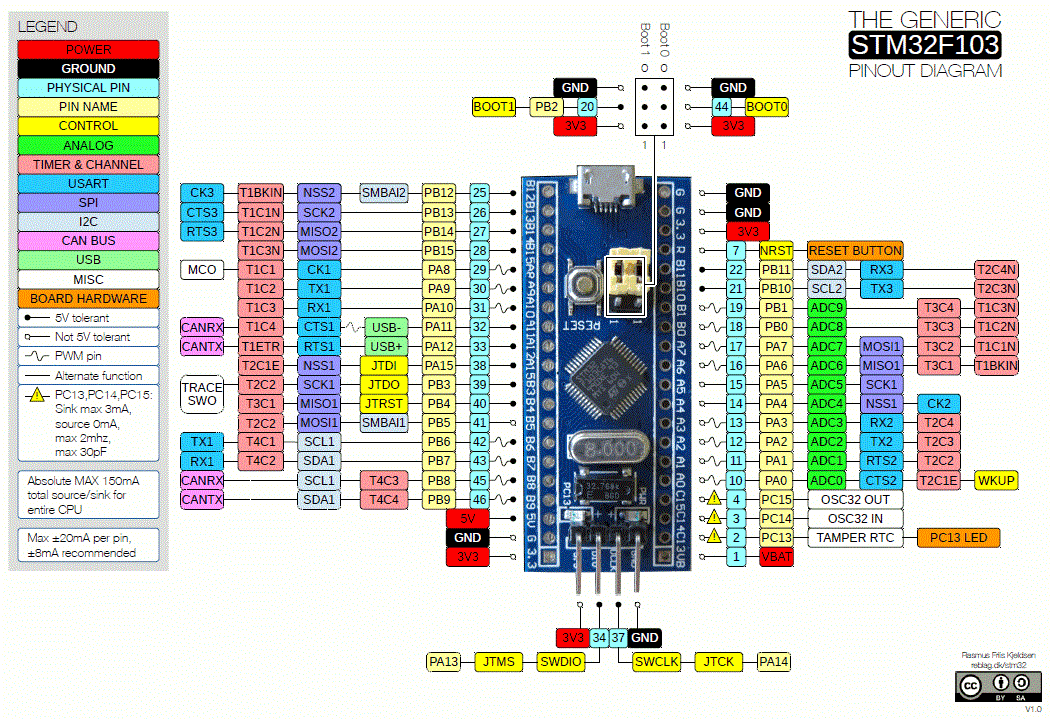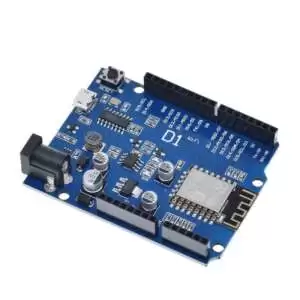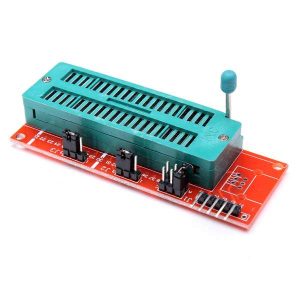The Blue Pill is a development board based on STMicroelectronics’ STM32F103C8T6 microcontroller that has an ARM Cortex-M3 core that runs at 72MHz max. Software libraries are available that allow users to program the chip using the Arduino IDE.
STM32F103C8T6 Specifications
The ARM Cortex M3 STM32F103C8 Microcontroller is used in the Blue pill board. Unlike the name, “Blue Pill” the Microcontroller’s name STM32F103C8T6 has a meaning behind it.
- STM » stands for the manufacturer name STMicroelectronics
- 32 » stands for 32-bit ARM architecture
- F103 » stands to indicate that the architecture ARM Cortex M3
- C » 48-pin
- 8 » 64KB Flash memory
- T » package type is LQFP
- 6 » operating temperature -40°C to +85°C
Now let us look into the specifications of this Microcontroller.
- Architecture: 32-bit ARM Cortex M3
- Operating Voltage: 2V to 3.6V
- CPU Frequency: 72 MHz
- Number of GPIO pins: 37
- Number of PWM pins: 12
- Analog input Pins: 10 (12-bit)
- USART Peripherals: 3
- I2C Peripherals: 2
- SPI Peripherals: 2
- Can 2.0 Peripheral: 1
- Timers: 3 (16-bit), 1 (PWM)
- Flash Memory: 64KB
- RAM: 20kB
- Burning times: 10k cycles
- On-board SWD interface and it can be programmed with ST-LINK V2
- Immersion gold process, long service life
- On-board reset button and power indicator LED
- Power supply connector: Micro USB socket
- On-board test indicator LED and the beginners can program to control it
- On-board 100ma 3.3V Regulator
- Size: 53mm x 22.5mm
STM32 Pin Details
The complete pin-outs of the STM32 Blue pill board are shown below. As you can see each pin is neatly labeled against it. The labeling is also similar to the Arduino boards. That is the G is used to denote the ground pin, 3.3V outputs a regulated 3.3V and the 5V pin can either be used to power the board or obtain the +5V if powered via micro USB. The onboard LED is connected to the PC13 pin of the Microcontroller.
Understanding Blue Pill
The Blue Pill is a 32-bit Arduino-compatible development board that features the STM32F103C8T6, a member of the STM32 family of ARM Cortex-M3 core microcontrollers. This board aims to bring the 32-bit ARM Cortex microcontrollers to the hobbyist market with the Arduino-style form factor.
Powering your Blue Pill:
There are three ways of powering your Blue Pill development board:
- Using the built-in USB micro connector.
- Supplying 5V to the 5V pin as an external supply.
- Supplying 3.3V directly to the 3.3V pin.
Input/Output:
The Blue Pill has 37 GPIO pins spread across four ports – A and B (16 pins), C (3 pins) and D (2 pins). Each pin has a current sink/source ability of 6mA. Pull-up and pull-down resistors can be enabled on each of the pins.
Most pins have extra functionality as well:
- Serial ports – receive and transmit data via the UART protocol
- I2C ports – two-wire communication via the IIC protocol
- SPI – serial communication
- PWM
- Pin 13 has a built-in LED
These special functions and their respective pins are illustrated in the Blue Pill pin diagram shown above.
How to Use the STM32 Development Board?
The Blue Pill can be programmed in two ways–
- Using an external USB/Serial converter connected to UART1 pins, which is the default bootloader for this family of boards. It can be programmed using the Arduino software this way.
- STLink USB Dongle – this uses the single-wire debug interface to communicate with the board. This allows it to be programmed using advanced software like Keil/CubeMX. It also allows memory access using the STLink software.
Before programming, it is important to connect the BOOT0 jumper to 1 and press the reset button to put the chip in ‘programming mode’.
Uploading Your First Program
If programming using the Arduino software, the appropriate board files should be downloaded using preferences and boards manager.
Then the correct board must be selected on the board’s menu.
Since the built-in LED is on pin 13, just like the Arduino, the basic blink sketch will work on the Blue Pill.

















Reviews
There are no reviews yet.